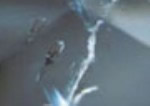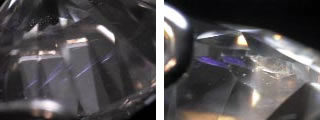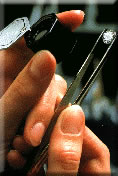Before you choose a diamond, it’s important to understand what clarity is and how it can be manipulated. There are several techniques that are used to “enhance” the clarity so that it appears better to the eye. These techniques impact the value of the stone, especially those that are not permanent changes.
Laser Drilling Removes Inclusions
 A tiny laser beam is used to drill into the diamond, tunneling-in to remove inclusions. A beam of high energy light is used to bore a small tunnel from the surface of the diamond to the targeted inclusion. Strong acid is then forced down the tunnel to bleach out or burn away the inclusion. Laser drilling typically leaves lines that resemble tiny jet trails, visible under side-view magnification. You’ll see a tiny white dot when viewing the trails from the top of the diamond.
A tiny laser beam is used to drill into the diamond, tunneling-in to remove inclusions. A beam of high energy light is used to bore a small tunnel from the surface of the diamond to the targeted inclusion. Strong acid is then forced down the tunnel to bleach out or burn away the inclusion. Laser drilling typically leaves lines that resemble tiny jet trails, visible under side-view magnification. You’ll see a tiny white dot when viewing the trails from the top of the diamond.
A newer type of laser enhancement creates cracks around inclusions near a diamond’s surface. The imperfection is removed, and the marks left behind look more like natural flaws than laser trails.
Laser drilling removes inclusions permanently and does not alter the strength of a diamond. Normal cleaning and the heat produced during setting repairs won’t change the appearance of the stone.
Laser drilled areas that are filled-in with a clear substance are more difficult to detect. The filler should not be considered permanent.
When first introduced, the use of laser drilling was not adequately disclosed to consumers. Even Federal Trade Commission (FTC) guidelines for the jewelry industry did not require disclosure of the practice. This lack of candor by diamond wholesalers and manufacturers brought an out cry from jewelry retailers and consumers. Today all reputable jewelry organizations require full disclosure of laser drilling and the FTC is considering a revision of its guidelines. Protect yourself by only buying a diamond from the AGS, GIA or EGL grading laboratories and avoiding diamonds noted as being laser drilled or clarity enhanced.
Fracture Filling Fills Cracks
 All diamonds have minute fractures and fissures. When the fissures are large and numerous they can detract from a diamonds beauty and value. In lower grade diamonds these fissures can give the diamond a cloudy, whitish appearance and may be visible to the naked eye.
All diamonds have minute fractures and fissures. When the fissures are large and numerous they can detract from a diamonds beauty and value. In lower grade diamonds these fissures can give the diamond a cloudy, whitish appearance and may be visible to the naked eye.
 In the late 1980s a new process was developed to hide the fissures. Known as “fracture filling” the process involves filling the fissures with a glass-like substance that is formulated to mimic the color and optical properties of the diamond being treated. As a result, the fissures in a fractured-filled diamond become less visible as in the before (left) and after (right) photo.
In the late 1980s a new process was developed to hide the fissures. Known as “fracture filling” the process involves filling the fissures with a glass-like substance that is formulated to mimic the color and optical properties of the diamond being treated. As a result, the fissures in a fractured-filled diamond become less visible as in the before (left) and after (right) photo.
The cracks don’t disappear, but the film creates an optical illusion that makes them invisible to the naked eye. Fracture filling is not a permanent treatment. Heat from repairs, cleaning, and sunlight can erode the filler or darken its color.
 Some signs of fracture filling can be seen using a 10X jeweler’s loupe, but others require a microscope. With magnification, you might see flashes of color where cracks have been filled. The flashes aren’t like the typical brilliant colors you see when rotating a stone. Instead, they follow the lines and shapes of the filled cracks. Trapped air bubbles are another sign of fracture filling, either singly or in groups that create a cloudy appearance.
Some signs of fracture filling can be seen using a 10X jeweler’s loupe, but others require a microscope. With magnification, you might see flashes of color where cracks have been filled. The flashes aren’t like the typical brilliant colors you see when rotating a stone. Instead, they follow the lines and shapes of the filled cracks. Trapped air bubbles are another sign of fracture filling, either singly or in groups that create a cloudy appearance.
Unfilled cracks may produce color flashes, too. The Gemological Institute of America (GIA) offers helpful advice that unfilled breaks are easiest to detect when looking at them from a perpendicular angle, while filled breaks are more obvious when looking at them from a parallel perspective.
Protect yourself by buying a diamond with a certification from the AGS, GIA or HRD. These grading laboratories test diamonds for fracture filling and do not provide certifications for diamonds that have been clarity enhanced with fracture filling. It is our understanding that the EGL will list clarity enhancement in the comment section of their diamond grading reports.
Some names for fracture-treated diamonds include Yehuda treated diamonds, Koss-treated diamonds, and Goldman Oved treated diamonds. Most Yehuda diamonds are certified by either the Global Gemological Laboratory (GGL) or the European Gemological Laboratory (EGL).
Fracture Filling Not Permanent
If you’re buying a diamond engagement ring or other diamond jewelry that will be worn continuously, a filled stone may not be the best choice, since the treatment is not permanent.
“Enhanced” is Not a Positive Term
Be wary if someone insinuates that the word enhanced is a positive feature. It does sound more desirable than the term treated, but it means the same thing. Find out which treatments were used and how those treatments affect the value of the diamond, its long-term appearance, and the care you should give it.
Treatments allow consumers to own a diamond that appears to be of a higher quality than it truly is, and there’s nothing wrong with buying a treated diamond if those treatments are disclosed and you pay an appropriate price for the stone.
Jewelers Should Disclose
In its “Revised Guidelines For The Jewelry Industry”, compiled January 2001, the FTC strongly stated that “it is illegal for a Diamond Seller NOT to disclose that a diamond has been Clarity-Enhanced by fracture-filling.”
Knowledgeable, reputable jewelers will disclose that treatments were made to diamonds they offer for sale, but let’s face it, not everyone is knowledgeable or reputable. The solution is to arm yourself with as much information as you can before you shop for diamonds. You won’t become an expert overnight, but you will have a better understanding of what you’re looking at and you’ll know which questions you should ask before you make an important purchase. In the end, your AGS or GIA certification is your best protection.
